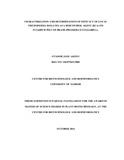| dc.description.abstract | Recent studies show Trichoderma species are not only parasites of fungal plant pathogens
but also can enhance plant growth and development. Heavy applications of
agrochemicals in soils in Embu County due to dependence on inorganic fertilizers and
pesticides have potential to cause negative effects on environment leading to decrease of
food production in agriculture. A study was conducted to evaluate virulence efficacy of
local Trichoderma isolates as Biocontrol Agent (BCA) on soil pathogenic fungi. Isolates
of Trichoderma koningii, Trichoderma asperellum, Trichoderma atroviride, Trichoderma
reesei, and Trichoderma harzianum from Embu soils were evaluated for their ability to
inhibit the mycelial growth of pathogenic fungi Fusarium oxysporum f.sp. phaseoli., in
culture. Trichoderma spp. were also evaluated for the suppression of Fusarium
oxysporum f.sp. phaseoli., under greenhouse condition. Trichoderma spp. were further
investigated for their ability to promote plant growth and development of maize and bean
seedlings in Embu County in Kenya. Subsequently, genetic characteristics of the five
Trichoderma isolates were analyzed to confirm bioefficacy activities in relation to their
molecular similarity.
Trichoderma isolates significantly (p < 0.01) reduced the mycelial growth of the
pathogen. Growth suppression by Trichoderma reesei against Fusarium oxysporum f. sp.
Phaseoli., had the highest effect in inhibition of mycelial growth (60.0%) with p-value
0.018), followed by Trichoderma koningii (55.2%) with (p=0.014) deploying antibiosis
and mycoparasitism mechanisms. Differences were observed with treatment of
Trichoderma reesei combined Manure recording the highest with seed emergence
germination index of 1.88, followed by Trichoderma koningii combined Fusarium
oxysporum (1.86). The application of inoculum with Trichoderma koningii combined
Fusarium oxysporum (6.7%) and Trichoderma reesei combined Manure (6.7%) gave the
highest reduction in disease incidence of Fusarium wilt on bean plants. Treatments with
manure increased the shoot height by 36.6 mm followed by inoculation of Trichoderma
koningii + Manure (35.2) and Trichoderma koningii (34.7). Effects were highly
significant at p < 0,001 with f- value of 4.716. The highest rate of seedling emergence
was 84% for maize seeds coated with the Trichoderma inoculum and planted in soil
amended with manure. Similarly, differences were observed with Manure +
Trichoderma treatment of 74.40% and Manure (74.00%) recording the highest
germination rates followed by both Trichoderma treatments with both TSP/CAN and
Mavuno (69.60%). This study demonstrated that local isolates of Trichoderma reesei and
Trichoderma koningii were identical in their biocontrol characteristics as well as potential
for use as biological control agents to protect bean plants from Fusarium oxysporum f.sp.
phaseoli., | en_US |

